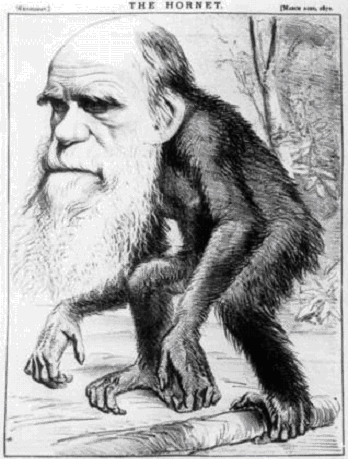Darwinism and society at large
In spite of the complexity of the theory and the difficulties arising from it, On the Origin of Species was a watershed. In the following decades, it became gradually well-nigh impossible for scientists belonging to academic networks to deny Evolution. The book is scholarly and sets forth a long compilation of data Darwin deemed evidence of his theory. Published by a specialised publisher, John Murray, the book was an immediate success the first issue (some 1200 copies) sold out in one day; six further editions followed and eight reprints until 1876. Still, in Darwin's lifetime in the UK, no more than 20000 copies were sold. By comparison, Essays and Reviews, a collective work around a rationalist critique of the Bible published in 1860 and which created a furore sold 22000 copies in a matter of months. In France 146000 copies of Renan's Life of Jesus were distributed in 18 months (1863-1864). However, Darwin's was a landmark book and was immediately translated into all European languages from German and Dutch in 1860 right onto Spanish in 1877 and Serbian in 1878. Altogether, the book would be translated into 36 languages. Even though it was not universally read, the book was known through commentary and indirect links. It was published at a time when technical progress mainstreamed the mass production of the printed word and upgraded image reproduction techniques.
Some disputes were reported in the mainstream press, including popular sheets. For the most part, they bore upon one key issue: that of the kinship between humans and monkeys whence arose the question of morality. And yet Darwin, who had no wish to fan polemical flames, had virtually kept humans out of On the Origin of Species, merely dropping the casual observation mid-paragraph that they were no exception. Through no decision of his own, this theme was soon exploited pictorially and Darwin's name, along with an reduced version of his theory (living beings evolve, humans are descended from monkeys) stole abroad by means other than the printed text.
Cartoons were to play a major part in this. Caricature had grown exponentially in the 19th century and satirical sheets proliferated. In London, Punch, founded in 1841, modelled itself on the illustrated French newspaper Le Charivari first issued in 1832. In no time cartoonists had seized upon Darwin and his theory. Originally, the favoured image was that of a humanised monkey in line with the satirical representations of humans under animal traits. As early as May 1861, Punch published a cartoon of a gorilla with a sign stating: “Am I a human and a brother?” alongside an unsigned poem “Monkeyana” addressing the issue of men's simian ascendency
“Mr Gorilla” became a recurring figure in Punch, embodying an animal more intelligent and wiser than men and exposing the times' foibles. Later, Darwin himself was given centre-stage. With highly recognisable features (baldness, long white beard) also disseminated by a fast-developing photographic expertise, Darwin's face was easily identifiable in the drawings published by satirical magazines. “Mr Bergh to the rescue”, published by Harpers Weekly on 19 August 1871 casts three characters: acting on the complaint of an affronted monkey, Henry Bergh, founder in 1866 of the American Society for the Prevention of Cruelty to Animals, admonishes an unmistakable Darwin .
Very soon however, the two images, the monkey's and Darwin's came to overlap bringing out a third image soon to become the quintessential Darwinian cartoon. On 22 March 1871 The Hornet thus sets forth a realistic portrait of the scientist placed on the body of an Orang Outang, also quite realistic. The hairiness of the monkey's body, the piece of wood clawed by the Darwin-monkey's foot, there to recall its quadrumanous status press home the meaning of the drawing. As from 1870, the French-speaking press, for instance the Petite Lune published similar cartoons. Some of the cartoons have openly sexual connotations and more particularly set forth the dangers Darwinism allegedly represents for morality: if humans have not been created by God, if their soul is not a splinter from the divinity, moral values are no longer steeped in an intangible foundation.








